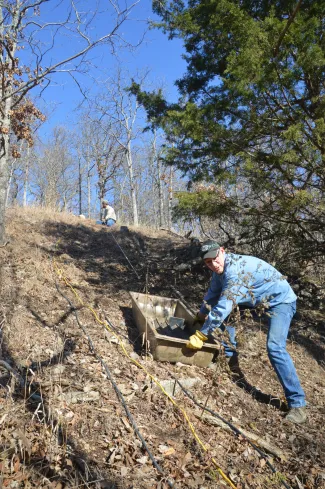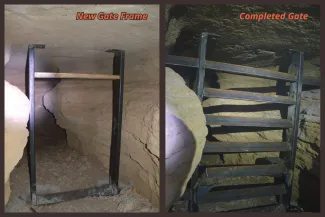Deep in the hills of Delaware County, a small cave waits for spring’s return of migrating gray bats. Biologists took steps this winter to make the habitat safer for the endangered bats by installing a gate within the mouth of the cave. (Though named “Iron Gate,” the cave hasn’t been protected by a gate in recent history.)
One hundred eighty feet. Half the length of a football field and the exact distance from the truck parked on the top of the hill to “Iron Gate Cave” and the work site below. Though short in distance, the trail down includes a steep slope, loose rocks and fallen leaves that are deceptively slick.
At the end of the trail, a rock tunnel leads into a limestone cave where a new gate is being installed to minimize disturbance to any wildlife – including bats – that may call the area home.
“We’ve done a lot of the design work for the gate in our shop,” said Russell Perry, biologist for the Oklahoma Department of Wildlife Conservation. “Several pieces of angle iron have been cut to fit the width of the cave walls and now we need to get those 30-40 pound pieces down the hill and welded in place.”

A small sled typically commissioned to haul downed deer was used to deliver most of the heavy materials to the work site.
Oklahoma’s caves have long been protected from human entry, but the design has changed considerably in the last quarter-century. Full doors or metal cages covering the entrances have largely been replaced with a series of horizontal bars made of angle iron that are placed about 50 feet into the cave, or further into the dark zone. These “dark zone” gate locations were first attempted nationwide in our state when exterior features at the mouth of two caves in Delaware and Adair counties wouldn’t allow for the traditional cage design. Since then, interior gates have become accepted protocol for cave gating throughout the United States.
When all the supplies arrive at the mouth of Iron Gate, Perry and a six-person team form an assembly line and begin passing the beams that will eventually be welded to the newly installed frame.
“We brought the frame in yesterday and anchored it in a foot of concrete,” said Perry. “These horizontal bars will be welded to the frame and spaced so that the bats can still safely fly into and out of the cave.”

Though mostly vacant in winter months, Iron Gate Cave has served as a maternity ward for gray bats in the past, including last spring when their more traditional maternity roost was flooded and the bats chose Iron Gate Cave as a substitute. This cave also houses a few overwintering bats and is a summer roosting spot for species like the tri-colored bat and federally threatened northern long-eared bat. A variety of specialist insects and salamanders have also been documented using Iron Gate throughout the years.
“Our ‘cave bats' are sensitive to human disturbance, especially during their winter hibernation and their spring and summer maternity season,” said Perry. “The goal of this new gate is to give the bats a little more protection so that they can continue to survive in our state.”
Learn about other efforts to help Oklahoma’s bats.
Supplies for and construction of this cave gate were provided by a Wildlife and Sport Fish Restoration Program Grant F17AF00822, with technical support from Dr. Keith Martin and Bill Puckette.